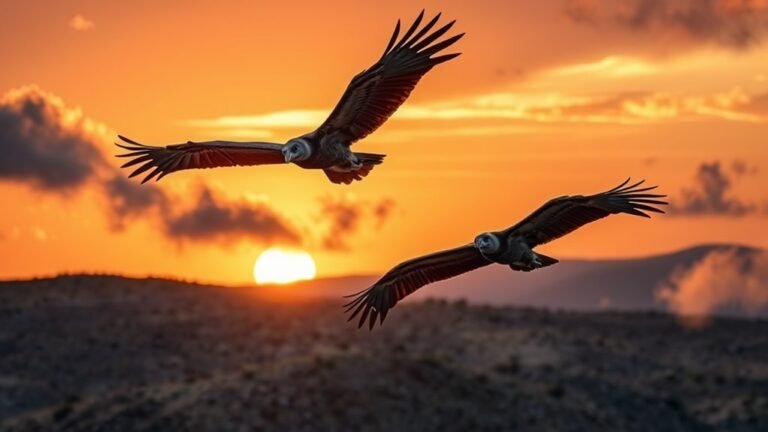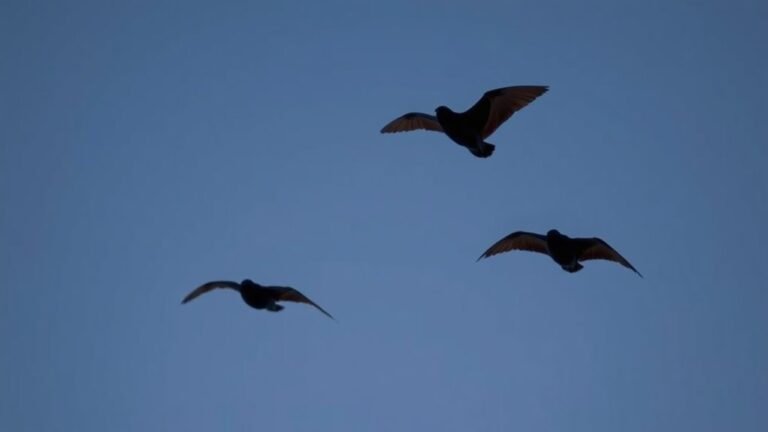What Bird Sounds Like a Whistle or Flute? Musical Mimics
In a forest, you may hear the sweet, flute-like calls of the Wood Thrush. This bird stands out with its joyful whistles and haunting echoes. Listening to its song creates a beautiful sound experience. The Wood Thrush communicates well with its surroundings. Other birds, like the Northern Mockingbird and European Starling, also make interesting sounds worth hearing.
Key Takeaways
- The Wood Thrush sings with beautiful, flute-like calls in forests.
- Northern Mockingbirds imitate many sounds, including flute-like tunes.
- The Eastern Whip-poor-will has a repeated whistling call heard at dawn and dusk.
- American Robins add cheerful whistle-like notes to their songs.
- The musical sounds of these birds create a rich listening experience in their habitats.
Understanding Birdsong

As you listen to the melodic notes in the woods, you may wonder about birdsong. Each call and trill creates a unique pattern, relaying important messages among birds. These sounds serve clear purposes, such as claiming territory or attracting mates.
Birds learn to identify familiar tunes and differentiate them from new ones, changing their behavior based on what they hear. Young birds often imitate the calls of adults, showing their desire to connect and belong to their social groups.
The Science of Bird Vocalization
Bird vocalization is a fascinating aspect of how birds communicate. Their calls aren't random; they develop through song evolution influenced by environment and social interactions. Each bird species produces unique sounds, often learned by young birds from their parents and neighbors. This learning ensures that their songs remain relevant in their communities.
Bird calls serve many purposes. They help attract mates and establish territories.
These vocal patterns also connect birds within their species. Overall, bird vocalization is an important part of how birds adapt to their environment and interact with each other.
Notable Musical Mimics in North America

Have you ever listened closely to a bird mimic sounds in nature? In North America, notable musical mimics include the Northern Mockingbird and the European Starling.
These birds take sounds from different musical genres and blend them into their songs. The Northern Mockingbird, for example, can copy tunes from various songbirds.
This ability creates a rich soundscape that reflects the diverse wildlife around it. Watching these birds perform connects us to both nature and human creativity.
Each note they sing reminds us of the beauty in both bird and human expression, making for a delightful experience.
The Flute-like Sounds of the Wood Thrush
The Wood Thrush is known for its beautiful, flute-like calls that echo in North American forests during the breeding season. Its song features clear tones and intricate phrases.
You can hear it switch between soft, haunting notes and bright, cheerful whistles. This creates a harmonious sound that fills the woods.
The Wood Thrush's music marks its territory and invites listeners to enjoy the beauty of nature. As evening approaches, its singing encourages people to stop and appreciate the moment.
The Wood Thrush's enchanting calls remind us to connect with our surroundings.
The Whistling Calls of the Eastern Whip-poor-will

The Eastern Whip-poor-will is a unique bird known for its distinctive whistling calls. These calls sound like "whip-poor-will" and can be heard in open woodlands and shrubby areas during dusk and dawn.
The bird vocalizes with persistence, making its presence known in the evening air.
Listening to the Whip-poor-will creates a special connection to nature. Its calls add charm to the environment, inviting attention from curious observers.
Engaging with this bird's song allows you to appreciate the beauty of less-known species, fostering a sense of community among the birds around you.
The Playful Mimicry of the Northern Mockingbird
The calls of the Eastern Whip-poor-will are beautiful, but the Northern Mockingbird's mimicry is even more remarkable.
These birds can imitate over 200 species. They can copy sounds like car alarms and human voices. They sing at all hours, showing their energy. Male mockingbirds often engage in vocal duels with each other. Their songs change based on their location, making their performances unique.
The Northern Mockingbird captures our attention with its playful sounds, helping us connect with nature. Its ability to mimic adds a layer of wonder to our outdoor experiences.
The Sweet Melodies of the American Robin
In the early morning light, the melodies of the American Robin fill the air, marking the arrival of spring. Their distinct songs are a mix of joyful whistles that echo through neighborhoods and parks.
You can observe these intelligent birds perched, singing to mark their territory or attract mates. Their songs vary; some notes are soft while others are lively, reflecting their feelings.
Sometimes, they mix simple phrases, creating a rich sound that captivates those who take a moment to listen. These beautiful melodies enhance nature's allure and encourage a sense of connection with your surroundings.
The Tricky Imitations of the Eurasian Wren
The Eurasian Wren is a small bird known for its impressive ability to mimic sounds.
You can hear the wren imitating various noises in your garden, such as:
- Whistles from other birds
- Rustling leaves
- Human-made sounds
- Calls from different species
- The gentle sound of water
These imitations help the wren blend into its environment, protect its territory, and attract mates.
Observing the wren's vocal skills allows you to enjoy the rich sounds of nature as it creates its own unique melody.
Unique Songs of Tropical Birds
In tropical rainforests, colorful birds produce unique songs. These sounds fill the air and reflect the nature of their habitats.
When you go birdwatching, you may hear different calls that serve important roles, like claiming territory or attracting mates. For example, the orange-bellied euphonia has a striking call that adds to the natural symphony.
Listening to these birds helps you connect with nature and enhances your experience in the tropical wilderness. Each song reveals the identity of the bird, making every moment a joyful discovery.
The Role of Song in Bird Communication
Bird song plays a vital role in bird communication. It provides insight into social interactions and environmental awareness. Through their songs, birds convey feelings and intentions, connect with one another, and understand their surroundings.
Learning about bird song deepens our appreciation of their lives and relationships.
Key functions of bird song include:
- Social bonding: Birds use song to strengthen their connections with others in the flock.
- Territorial claims: Songs help birds establish and protect their feeding areas.
- Mating rituals: Male birds attract mates through beautiful and complex songs.
- Communication of danger: Birds warn each other of nearby predators through specific calls.
- Social learning: Young birds learn songs from older birds, aiding their development.
Tips for Identifying Bird Songs in the Wild
How can you identify bird songs in nature? Start with birdwatching skills.
Listen for patterns in rhythm, pitch, and tone. Each bird species has a unique song or call with a clear structure. Practice by linking specific melodies to the bird you see.
Use apps and field guides to learn about local birds. Pay attention to context; note where and when you hear a sound, as some birds sing in certain habitats or at specific times.
Lastly, consider joining a birdwatching group to share your experiences. This can enhance your enjoyment and help you build connections with other nature lovers.
Frequently Asked Questions
What Time of Day Do Birds Typically Sing the Most?
Birds sing most during the dawn chorus, right before sunrise. This time is lively, as many birds communicate through song. You will hear their vibrant calls as light appears, creating a beautiful natural symphony. Enjoy this moment to connect with nature and appreciate the sounds of the morning.
How Can Weather Affect Bird Vocalization?
Weather affects bird vocalization in several ways. When temperatures rise, birds become more active and sing more often. In contrast, high humidity levels can reduce the clarity of their sounds, making it harder to hear their songs. Understanding these effects can help you appreciate bird sounds in different weather conditions.
Do All Birds Have a Singing Season?
Not all birds sing throughout the year. Many birds have specific singing seasons that align with their breeding habits and territorial behaviors. During these seasons, you will hear more vocal activity as birds establish their territories and try to attract mates. This increase in song is an important part of their natural behavior.
Can Birds Recognize Each Other's Songs?
Yes, birds can recognize each other's songs. They use song variation to identify individuals and establish territory. These interactions show their social structures and strengthen their community ties. Birds communicate through their songs, which helps them connect with one another and build relationships.
How Do Environmental Changes Impact Bird Songs?
Environmental changes, such as habitat loss and noise pollution, impact how birds communicate. Birds modify their songs by making them shorter or louder. These adjustments reflect their fight for survival and emphasize the balance in nature's ecosystems. Understanding these changes helps us appreciate the challenges birds face in a changing world.

Ava is a bird enthusiast and nature lover who has spent countless hours observing and learning about the fascinating world of birds. With a passion for sharing her knowledge and inspiring others to appreciate the beauty of birds, Ava writes about her experiences and insights on avianadmirer.com.







